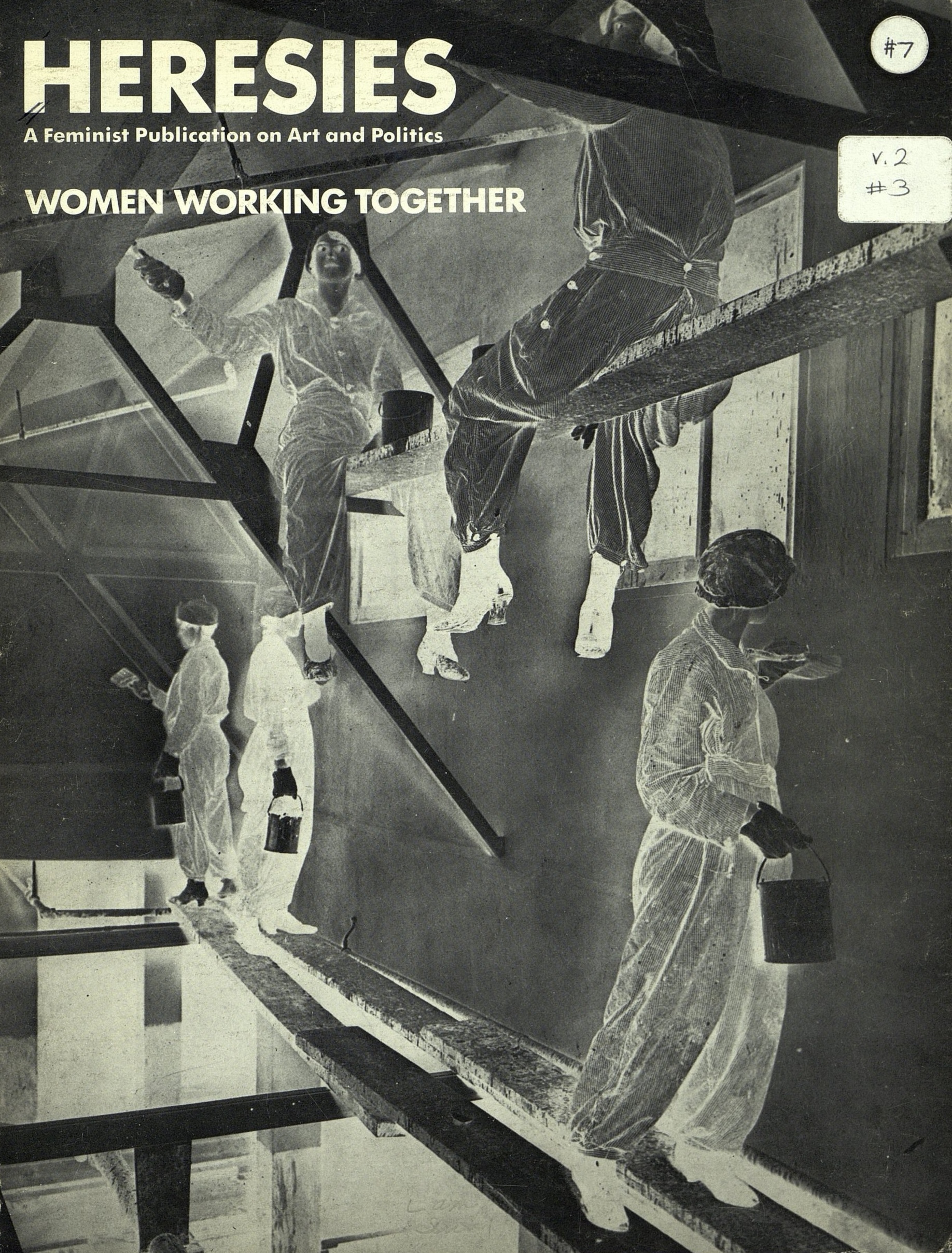Women Working Together
Heresies Vol. 2, No. 3, Spring 1979
-
-
The Issue 7 Collective
Heresies collective: Ida Applebroog, Patsy Beckert, Joan Braderman, Su Friedrich, Janet Froelich, Harmony Hammond, Sue Heinemann, Elizabeth Hess, Arlene Ladden, Gail Lineback, Lucy Lippard, Melissa Meyer, Marty Pottenger, Carrie Rickey, Elizabeth Sacre, Miriam Schapiro, Amy Sillman, Elke Solomon, Pat Steir, May Stevens, Elizabeth Weatherford, Sally Webster
Associate members: Mary Beth Edelson, Joyce Kozloff, Joan Snyder, Michelle Stuart, Susana Torre, Nina Yankowitz
Staff: Birgit Flos, Sue Heinemann, Gail Lineback
From the Issue 7 Collective
EDITORIAL
The Heresies #7 Editorial Collective.
We haven’t yet learned to analyze 'women working together.' When a group is working well,
we assume nothing is worth analyzing. When problems get hairy, we’re so bummed out that we grab
the handiest explanation (’If only she’d stop doing
that, everything would be okay’; Nobody is committed
enough’ ). Women need to develop ways of thinking,
looking, talking about our processes. That it is frequently painful to work together cannot be permitted
to excuse us from examining what is going on. In the
women’s movement, we finally started sharing bedroom secrets. It’s about time we talk as frankly about
the internal cleanliness and dirt in our collectives.
Eventually, the sacred moral tones can be replaced by
practical discussions that could also provoke exciting
analysis.
We have been working together
for about a year. We share a sense
of confusion, disappointment and
frustration as we look back. For a
while, the causes of our malaise
were obscure to us. Although we
had our share of angry exchanges,
we did not suffer from evident political division or serious, chronic, per-
sonal antagonism.
I have really enjoyed the people
working on the issue. Getting to
know the women has been important
to me.
In general, the women in our group
are clear about themselves and their
lives and have shown themselves to
be pretty open and direct in dealing
with each other.
We established a “friendly-but-
impersonal collegial atmosphere’
which we would only later call a
conspiracy of niceness. Months
later, we remain friendly, more often
than not “cheerful and polite with
“comfortable in our
each other,
work.
Yet something went wrong.
It was far more boring than it was
stimulating.
The decision-making processes have
been tedious and verbose.
It seemed that we so often looked for
the weak points in the articles we received (or in the back issues of Heresies) that I began to lose confidence
and interest.
Our “conspiracy of niceness” took
its toll. Although we might have been
“appalled that one or two people
could, at times, so effectively control
the time, energy and direction of the
group,” we were usually “too polite’
to name—let alone to deal with—the
problem. A kind of disaffection set
in; as a result, “we did not allow
ourselves to respect our mutual decisions. And, it seemed:
We know very little about one another’s lives.
We don’t respect each others’ feelings about writing solicited or submitted.
Everyone in the collective seemed to
connect through a web of mutual
acquaintances with other members
of the collective or people outside—
whom I never knew or had heard of.
I ended up feeling insignificant.
While we made some alliances
based on past friendships and current social, sexual and political allegiances, they were neither fierce nor
exclusive. Yet most of us felt locked
out, by and large, from what seemed
to be a cohesive group for the others.
Not surprisingly, in such an atmosphere,
We never became a work group, only the seeds of one. We did not agree
on our goals or the means we would
and wouldn’t use to meet them. Since
we did not commit ourselves to anything, we have not been able to demand much from each other nor has
the main Heresies Collective been
able to demand much from our group.
A certain cynical pragmatism became the dominant element of our
working together.
We talked, argued a bit, but never
became passionate. We became very
pragmatic decision-makers, reluctant workers, bare friends.
It is not a work environment I would
choose if there were other possibilities.
Now, toward the end of the time
we’ve worked together, we have
identified at least three of the causes
of our situation: our subject, our relation to the main collective, and our
prior self-identification as artists or
writers. From the outset, we found it
difficult to focus our issue’s topic.
We agreed that we were interested
in the experiences women had had
and the methods that had been developed in working together, in
either alternative or traditional
work structures. We did not want
sentimentality or idealization, but
“true confessions” of conflicts,
doubts and ambitions. Some of us
were primarily interested in traditional structures and ways of changing them. Others dwelt on general
questions about the meaning of work
or on conflicts between professionalism and feminism. Occasionally, it
seemed we wanted to include almost
anything women might do together
as part of our interest. These differences in emphasis caused some
misunderstanding and difficulty
within our group as we evaluated
the material we received or discussed solicitations.
Much more serious were the problems with our topic as we mutually
understood it. We—women in general—scarcely have a vocabulary
for talking about women working together. We hardly know the outline
of the subject, much less how to define solutions to its problems. There
are serious obstacles to “truth-
telling” among women, of which we
are only now aware. It often means
identifying specific people, which
threatens relationships and projects;
it requires self-exposure and makes
us feel vulnerable. For weeks, our
group could not understand why it
was so difficult to get material which
addressed our questions in an interesting, intelligent way. Now we
know that we are all inexperienced
in dealing with our subject, emotionally and conceptually.
In retrospect, we realize that
there was a vacuum —a lack of focus around which we could define
political and intellectual issues. Because we weren’t clear about our
topic, it was easy to make our goal
merely to get out the magazine. We
complained that we weren’t talking
enough, that there was too much
business, too little camaraderie,
politics or debate. We momentarily
would become “passionate” about
procedural matters or a particular
article. But this was no substitute for
political passion about substantive issues—hard to achieve about a topic which is both new and disturbing.
Because of the lack of passion and
goals, we were not sufficiently motivated to explore and modify the
personal relationships we felt were
increasingly unsatisfying.
These problems were compounded
by the particular history of our issue.
This issue originally was intended
as a project of the main Heresies Collective. It was to be a statement about
and examination of their process
and history, along with “true confessions” from other women’s groups
and collectives. When Heresies
realized they could not follow
through with their project, they
opened up the issue to the feminist
community. Coming to this decision
took time and meant, paradoxically,
that the issue was “late” before our
editorial group had ever met. We
were confronted with a practical
task: to put out an issue quickly, according to the schedule demands
and topic definition of the Heresies
Collective.
At first we were a shifting group
of women who appeared to be under
the direction of whichever member(s) of the main collective hap-
pened to be at that night’s meeting.
It was their task to clarify the project and to communicate a sense of
urgency about Heresies’ schedules.
Throughout the production of this issue, we have worked with a series of
unrealistic and unnerving deadlines
which blighted our spirits, inhibited
our thinking and bred numerous
resentments. By the time we might
have calmly and productively talked
of ways of finishing our project, we
no longer trusted ourselves or Heresies to be honest about any deadline,
and many of us could no longer care.
The three members of Heresies
who were part of our group were
torn between our editorial interests
and those of Heresies. The rest of us
came with varying degrees of commitment to, and familiarity with, the
magazine. But whatever our initial
allegiances, most of us occasionally
felt harassed and misunderstood by
a collective whose operations were
confusing, even unintelligible to us.
It was easy to feel antagonistic
toward the very group for whom we
were working and who made our existence possible. We had conflicts
with the larger collective over the
size of the issue, its budget, and our
time schedule. These problems became more explicit as our project
wore on. We sometimes felt that the
final control over “our” magazine
lay in “their” hands. This tended to
reinforce the sense of an adversarial
relation.
In our final months we have developed still another division—a strongly marked version of the split between writers and artists, which we
tend to justify as a split between
editorial and design. This division
has compounded the disconnectedness of the group.
The schism between the artists and
writers is very apparent. There is a
politic in it that hasn’t been dis
cussed. I am appalled to think that
discussion could be considered bullshit and that visuals could be seen
as merely decorative.
We decided collectively about the
value of written material. We were
shown visuals, but we didn’t discuss
them much and certainly didn’t vote
on them collectively. I couldn’t find
words to ask about the politics or
meaning of the visuals. I feel cut off
from a large part of the magazine.
My level of ambivalence about the
content of the issue is enormous. l’m
primarily concerned about design
and visuals.
I care more for the look and feel of
the publication, now, than for the
editorial work. I want to design a
beautiful magazine with the few of
us who care about design. I hope
that the editorial material will carry
its own weight, but I seem to have
separated myself from that.
At times it has seemed as if we
have two subcollectives with occasional cross-overs. Some of us didn’t
see each other for weeks.
All this is disheartening. But we
have stayed on. There are still ten of
us actively putting out the magazine.
We came together recently to reflect
upon our individual and collective
experiences. Now, at last, we are
engaging in the kind of nonjudgmental self-criticism necessary to group
projects. We have worked hard,
laughed a lot, and are feeling better
about our experience.
Although we are not happy with
the way we’ve worked together, we
do like what we have produced. We
see this issue as a groundbreaking
one. We are presenting material
which, as a whole, may allow all of
us to begin to see what “women
working together” looks like. Women
have many options: more and more
women are exploring them and feeling good about the results. It is good
to work together, but it isn’t easy.
We must learn to make compromises
and relinquish control, at the same
time maintaining political passion
and assuming our responsibilities.
We hope that this issue adds to the
body of information and usable wisdom that women can draw upon, not
just for inspiration but for practical
help in analyzing and solving our
difficulties.

